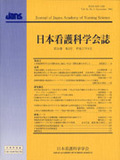Japanese
English
- 販売していません
- Abstract 文献概要
- 参考文献 Reference
要旨
本研究の目的は, 羊水検査を受けるか否かの決定過程についてFamiiy Powersの観点から分析することとした.
研究対象者は, 2001年8月から2002年6月までに産婦人科遺伝外来を受診した高齢妊婦で, 調査時点ですでに出産を終えており, 羊水検査を受けた場合は検査結果に異常所見がなく, 本調査の協力に同意した36名とした. 研究デザインは構造化内容分析に基づいた記述研究とし, 構造化および半構造化質問紙を用いた電話による聞き取り調査を行った.
羊水検査を受けるか否かに関する決定において, 28名 (77.8%)は夫または家族と話し合い, 8名 (22.2%)は女性単独で決定していた. 女性が話し合ったのが夫のみだった場合が24名 (66.7%), 夫と家族と話し合ったのが3名 (8.3%), 夫は含まず他の家族と話し合ったのが1名 (2.8%) であった.
女性の決定パターンは6パターンがあり, Family Power Balanceから見ると, 「合意して決める」という女性と家族が同等のパターン, 「自分に合わせてもらう」「自分の意見を通す」という女性が家族をコントロールするパターン, 「家族に合わせる」「家族に従わせられる」という家族が女性をコントロールするパターン, 「ひとりで決める」は女性単独で決定するパターンであると考えられた.
Abstract
Japanese people make too much of harmony with family or people with whom they have intimacy when they make a decision. Elderly pregnant women have the ethical dilemma between family's intent and their baby's life through amniocentesis. The purpose of this study is to identify the patterns of making a decision about amniocentesis and family powers involved for those who had discussed what to do about amniocentesis. A descriptive design, using a structured and semi-structured interview was used. Participants were thirty six older women who had visited Genetic Counseling in one tertiary setting about amniocentesis when they were pregnant. At the time of study they had already given birth. Data were collected by telephone interview on one occasion. Data were analyzed by content analysis.
Following results were found. Twenty eight (77.8%) women talked with family about amniocentesis and 8 (22.2%) did not. Twenty four (66.7%) families decided with couple only. Three (8.3%) families were couple and other family members and 1(2.8%) family was other family member. There were 6 patterns of family powers in the process of decision making about amniocentesis. These 6 patterns of family powers are'agreement in equilibrium','deciding alone', 'persuading family', 'forcing family', 'persuading woman,' and 'forcing woman'. From the results, women talk with husband and a few other family members.
Copyright © 2005, Japan Academy of Nursing Science. All rights reserved.


